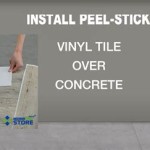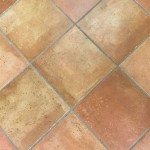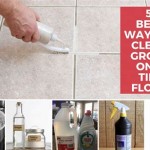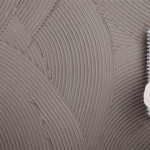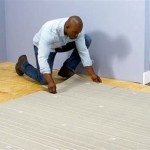How To Remove Asbestos Floor Tile Adhesive From Interior Walls
Asbestos, a naturally occurring mineral once widely used in construction materials for its heat resistance and tensile strength, poses significant health risks when its fibers become airborne and are inhaled. Prior to its regulation and subsequent ban in many countries, asbestos was a common component in floor tiles and the adhesives used to affix them. While most commonly associated with flooring applications, asbestos-containing adhesives could also be found on interior walls, usually in situations where tiles, panels, or other materials were directly adhered to the wall surface. Removing asbestos-containing materials, including floor tile adhesive from interior walls, requires careful planning, adherence to safety protocols, and compliance with local regulations to minimize the risk of exposure.
The presence of asbestos in floor tile adhesive cannot be determined by visual inspection alone. The only definitive way to confirm its presence is through laboratory testing. Before undertaking any removal work, it is imperative to have a sample of the adhesive analyzed by a qualified laboratory specializing in asbestos testing. This analysis will identify the type and percentage of asbestos present, which will inform the appropriate removal methods and safety precautions. Engaging a certified asbestos inspector to collect the sample and interpret the results is a recommended practice. The inspector can also advise on the necessary permits and regulations that apply to asbestos removal in the specific jurisdiction. Attempting to remove the adhesive without prior testing is ill-advised and exposes the homeowner to unnecessary risk.
Assuming the presence of asbestos is confirmed, there are generally two primary approaches to addressing the issue: abatement or encapsulation. Abatement involves the complete removal of the asbestos-containing material, while encapsulation involves sealing the material to prevent the release of asbestos fibers. The choice between these two approaches depends on various factors, including the condition of the adhesive, its location, the potential for disturbance, and local regulations. For floor tile adhesive adhering to an interior wall, the preferred method is typically abatement, as future renovations or repairs may inadvertently disturb the adhesive if it remains in place. However, in some situations, encapsulation might be considered if the adhesive is in good condition and unlikely to be disturbed.
Understanding Regulatory Requirements and Permits
Before initiating any asbestos removal project, it is crucial to thoroughly research and understand all applicable federal, state, and local regulations. Asbestos removal is often strictly regulated to protect workers and the public from exposure. Many jurisdictions require permits for asbestos abatement work, especially when the quantity of material exceeds a certain threshold. The permit application process typically involves submitting a detailed work plan outlining the removal procedures, safety precautions, and waste disposal methods. Failure to obtain the necessary permits can result in significant fines and legal penalties. Contacting the local environmental protection agency or health department is the best way to determine the specific requirements for asbestos removal in your area.
Furthermore, some jurisdictions mandate that asbestos removal work be performed by licensed and certified asbestos abatement contractors. These contractors have received specialized training in safe asbestos handling techniques and possess the necessary equipment to minimize fiber release. Even if not legally required, hiring a qualified contractor is strongly recommended, especially for homeowners who lack the experience and expertise to handle asbestos safely. A reputable contractor will be familiar with all applicable regulations and will ensure that the work is performed in accordance with best practices.
The regulations also extend to the disposal of asbestos-containing waste. Asbestos waste must be properly packaged, labeled, and transported to a designated landfill or disposal facility that is authorized to accept asbestos-containing materials. Improper disposal of asbestos waste can result in environmental contamination and legal ramifications. The asbestos abatement contractor will typically handle the waste disposal process as part of their service.
Preparing the Work Area for Asbestos Removal
Proper preparation of the work area is paramount to minimizing the spread of asbestos fibers during the removal process. The area must be isolated from the rest of the building using polyethylene sheeting and duct tape. These sheets should be thick, typically 6-mil polyethylene, and must be carefully sealed to all surfaces, including walls, floors, and ceilings. All openings, such as doorways, windows, and ventilation ducts, should be completely sealed to prevent air movement. Creating a negative air pressure environment within the work area is also recommended. This can be achieved by using a HEPA (High-Efficiency Particulate Air) filtered air filtration unit, also known as an air scrubber, which draws air out of the work area and filters it to remove asbestos fibers before exhausting it to the outside.
All furniture, belongings, and other items should be removed from the work area before commencing any asbestos removal activities. If it is not possible to remove certain items, they should be thoroughly cleaned with a HEPA vacuum and then covered with polyethylene sheeting. The work area should be clearly marked with warning signs indicating the presence of asbestos and restricting access to authorized personnel only. These warning signs should be prominently displayed at all entrances to the work area.
Personal protective equipment (PPE) is essential for anyone entering the work area during asbestos removal. This includes a properly fitted respirator with HEPA filters approved for asbestos use, disposable coveralls, gloves, and eye protection. The respirator should be fit-tested to ensure a proper seal and prevent the inhalation of asbestos fibers. The coveralls should be made of a non-woven material that prevents asbestos fibers from penetrating the fabric. Gloves should be disposable and made of a material that is resistant to the cleaning solutions used during the removal process. Eye protection, such as safety glasses or goggles, will protect the eyes from asbestos fibers and debris.
Asbestos Floor Tile Adhesive Removal Techniques
The most common method for removing asbestos floor tile adhesive from interior walls involves wetting the adhesive with a surfactant solution and then carefully scraping it away. The surfactant solution helps to encapsulate the asbestos fibers and prevent them from becoming airborne. A mixture of water and a small amount of dish soap or a commercially available asbestos wetting agent can be used as the surfactant solution. The solution should be applied liberally to the adhesive using a spray bottle or a sponge. Allow the solution to soak into the adhesive for several minutes before attempting to remove it.
Once the adhesive is thoroughly wetted, use a hand scraper or a putty knife to carefully scrape it away from the wall surface. Apply gentle pressure to avoid gouging or damaging the wall. Collect the removed adhesive in a sealed container, such as a heavy-duty plastic bag or a bucket with a lid. Avoid creating dust during the scraping process. If the adhesive is particularly stubborn, you may need to re-wet it and allow it to soak for a longer period. For large areas, consider using a floor scraper with a long handle to reduce the amount of bending and stooping required. However, exercise caution when using power tools, as they can generate dust and increase the risk of asbestos exposure. If power tools are used, they must be equipped with HEPA-filtered vacuum attachments to capture the dust at the source.
After removing the bulk of the adhesive, thoroughly clean the wall surface with a damp sponge or cloth to remove any remaining residue. HEPA vacuum the entire work area, including the walls, floor, and any surfaces that may have come into contact with asbestos fibers. Dispose of the used sponges, cloths, and other cleaning materials as asbestos waste. Once the removal is complete, a visual inspection should be conducted to ensure that all visible asbestos-containing material has been removed. In some cases, it may be necessary to have the area air tested by a qualified asbestos professional to confirm that the airborne asbestos fiber levels are below acceptable limits.
It is important to note that some asbestos-containing adhesives are very difficult to remove completely. In such cases, it may be more practical to encapsulate the remaining adhesive rather than attempt to remove it entirely. Encapsulation involves applying a sealant that will prevent asbestos fibers from being released into the air. This is generally done with a special paint-like substance designed for this purpose.
After the work is completed, properly dispose of all contaminated materials, including PPE, polyethylene sheeting, contaminated water, and adhesive debris, as hazardous waste according to local, state, and federal regulations. A licensed contractor should handle the disposal process. It's important to adhere to all regulations and guidelines to protect yourself and the environment. Asbestos floor tile adhesive removal is a serious issue, and careful planning and execution are essential for your health and safety.

Asbestos Floor Tile Is It Safe To Remove On Your Own

All You Need To Know About Removing Asbestos Floor Tiles Removal London

Asbestos Bitumen Glue Adhesive Removal Cost Guide For 2025

How To Remove Asbestos Floor Tiles Safely

Asbestos Encapsulation Floor Tile Encapsulate Mastics

Floor Asbestos Inside Your Home Debuild

How Much Does Asbestos Bitumen Glue Adhesive Removal Cost

Asbestos Removal And Vacuuming Kärcher International

Cleanup And Disposal Asbestos

Asbestos Floor Tiles
Related Posts

